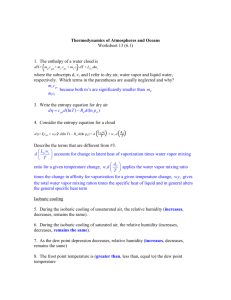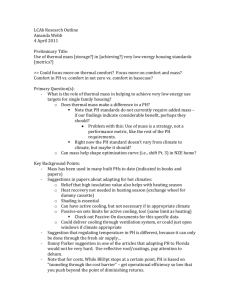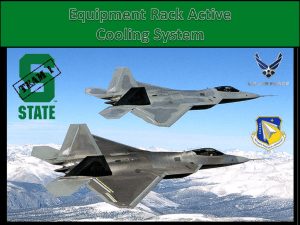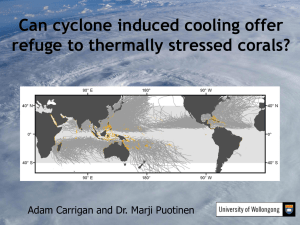Thermal Instability in Astrophysics: Presentation
advertisement
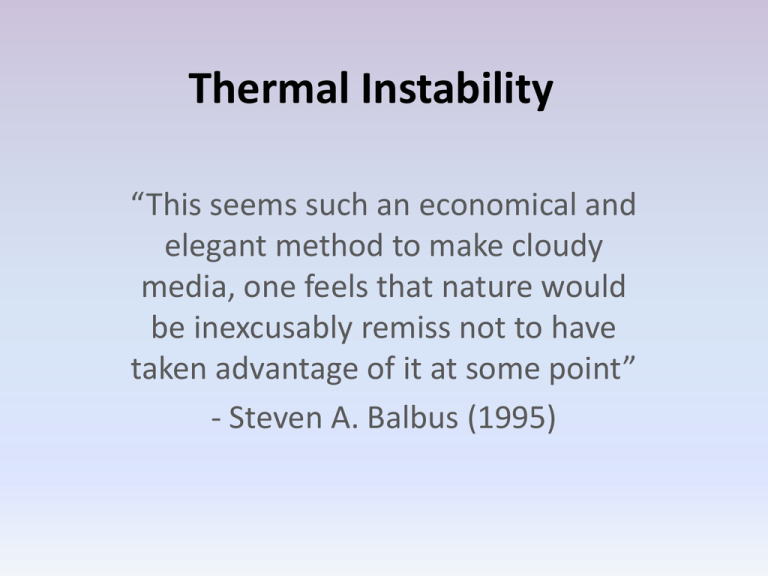
Thermal Instability “This seems such an economical and elegant method to make cloudy media, one feels that nature would be inexcusably remiss not to have taken advantage of it at some point” - Steven A. Balbus (1995) The Second Law T dS = dQ = -L dt Where L = cooling loss function (ergs/s·g) The instability criterion If δS and δ(L/T) have the same sign, then the parcel of gas tends to return to the background entropy. If they have different signs, then the parcel continues to evolve away from the background condition. The constant? For isochoric disturbances: dS = CρdT: For isobaric disturbances: dS = CPdT: Note that constant density (isochoric conditions) are quickly destroyed due to forces from pressure and temperature variations. Thermal Equilibrium In the limit of cooling function equilibrium (L = 0), the criterion for stability reduces to: This is violated in several regions of typical astrophysical cooling functions A little Themodynamic Analysis Consider the mathematical identity: Most* astrophysical cooling functions increase with increasing density (in regimes of interest), so: * For the Inoue and Inutsuka Cooling and Heating, this is only true for T > 2.5K Regions of Stability Thus, a criterion for stability in equilibrium is: Consider the Inoue & Inutsuka equilibrium: On the line of equilibrium there is a section of instability between two turning points. New equilibria? One can imagine an isobaric configuration (as on the dashed line) in the unstable region going to a thermal runaway, leading to a two or even three phase medium - cool clouds surrounded by a warm envelope. Condensation Mode When the full linear stability analysis is done (details mercifully omitted), the isobaric stability criterion corresponds to a condensation mode: • Field, 1965 – perturbations of the form yield the isobaric criterion as one solution of the characteristic equation for the case of expansion around the equlibrium solution L = 0 . • Balbus, 1985 – Using the WKBJ prescription, with a form of yields the isobaric criterion as one solution for the general case of any L. Overstability Other solutions arise in the linear stability analysis that correspond to acoustic modes with increased amplitude. The general logic goes like this: Consider a parcel of gas in a gravitationally stratified medium (hydrostatic eq). A small perturbation of the parcel will cause it to execute buoyant oscillations. On its upward excursion, if cooling were to dominate over heating, the return buoyant force would cause it to overshoot the maximum amplitude of an adiabatic blob after passing through equilibrium. Global Thermal Instability Balbus, 1995 showed that gravitational overstability is a false dichotomy, because convective stability is tied to thermal stability. However, the same logic applies to a planar shock in front of a wall. As the shock front begins to move upstream, the increased postshock pressure will not be supported by the downstream cooling gas, and the shock front will fall back, in general overshooting it’s initial position. As it moves backwards, the jump conditions weaken, decreasing the postshock pressure, etc. Global Thermal Instability Chevalier & Imamura, 1982 found this instability to occur in the longest wavelength mode for α < 0.4 for cooling of the form*: This implies a global ‘breathing mode’ for the shock front under certain conditions for certain power law cooling functions. However, this holds only for a shock in front of a wall. What about a shock-bounded slab? *Although most astrophysical cooling functions cannot be so easily represented, by taking d(ln L )/dT and comparing, the I&I cooling function never goes below α = 0.5 for any temperature, for example. Shock-bounded Slabs • For a wall-bounded shock, any condensation modes would be swept toward the wall and fail to condense further. • Similarly, in a shock-bounded slab, the central region is occupied by a growing cold layer that has traversed the cooling region. •The presence of acoustic overstable modes are dependent upon the size of the cold layer. Yamada & Nishi, 2001: Fig. 1 The cutoff temperature for a function that includes heat and cooling would be at stable thermal equilibrium. • The maximum final density of this layer also depends on the initial strength of the shock front. Shock-bounded Slabs Mach 3 flow, tcool < tNTSI Shock-bounded Slabs Mach 10 flow, tcool > tNTSI References • • • • • • Balbus, 1986 Balbus, 1995 Chevalier & Imamura,1982 Field, 1964 Inoue & Inutsuka, 2007 Yamada & Nishi, 2001



